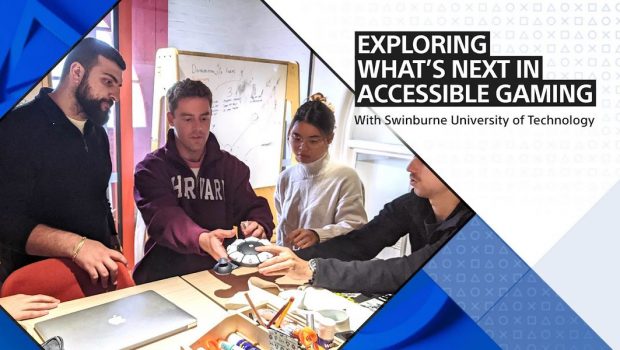The Next Generation Accessible Gaming – Exploring Future Applications with Students at Swinburne University Of Technology
The following is a summary of the collaboration between Sony Interactive’s Future Technology Group and Swinburne University of Technology in Melbourne, Australia, which explored how PlayStation’s Access Controller could be used beyond powering immersive play experiences.
Introduction
Innovation at Sony Interactive Entertainment is a pursuit that takes many forms and is often successful when done in coordination with valued partners. Different minds bring different ideas. The customizable and adaptive Access Controller, is one such example of harnessing innovation by providing a platform for persons with disabilities and forging our own path forward on challenges that require unique, flexible solutions. The controller is part of a wider ambition to ensure our products and services are accessible, to remove barriers for our diverse playing community.
In 2021, Sony Interactive’s Future Technology Group (FTG) was introduced as a dedicated entity for discovering, exploring, and ingraining fresh ideas across the organization and, by extension, the gaming industry. As part of FTG, I’m proud to discuss an undergraduate student collaboration to bring immersive play experiences to broader audiences via the recently released Access Controller, and an example of how we are continually developing our approach to innovation and using our creativity and technology to inspire change.
Swinburne University & The Design Factory
Lucy Hattersley is the Academic Development Manager at Sony Interactive Entertainment and is responsible for the academic research program in the United Kingdom, Europe, Australia and New Zealand. This involves cultivating and maintaining relationships within the academic space and collaborating on projects that have reciprocal benefits. Essentially, the lines are blurred between academia and industry. The two tend to have very different approaches — the former being more blue-sky and theoretical, whereas the latter is more applied — and mixing the two can create magical results. One of the latest ventures sought to expand the capabilities of the Access Controller by uniting diverse groups for a common cause, which has seen some exciting results so far.
The FTG’s formation allows SIE to seek out solutions in new, unprecedented ways. With the FTG looking at SIE from within, they’ve identified an opportunity to discover and invest in external support for fresh ideas and inspiration while attending the Compass Tech Summit in Budapest. It was there that SIE met the Swinburne University of Technology, based in Melbourne, Australia, to discuss applied innovation. This project hit several sweet spots, resonating with Sony Interactive’s deep-rooted approach to creating cutting-edge technology. It is also an example of how global this initiative was even from the beginning – starting in Budapest and ending in Australia.
In further talks with Swinburne, FTG discovered several things that made for the ideal partnership: similar ethos, very well-equipped laboratories with things like 3D printers and prototype rooms, and a long-time host to the Design Factory, a global network of innovation hubs. Swinburne has had experience running similar projects, and having the ability to give students an industrial problem to apply their studies and findings to benefit their real-world experience. It was truly a great fit from the start.
Fresh Ideas & Diversity of Thought
Once the project was underway, FTG established support and access for researchers, along with the project goals and extensive background. Of course, a key first step was supplying Access Controllers to pull apart or “hack.” The support FTG was able to provide included presentations by colleagues from teams at Sony Interactive responsible for design, sustainability, and accessibility. The controller was designed with input from several teams to cover a multitude of physical limitations, but FTG’s ultimate goal for this project was exploring new possibilities — what else could it do?
One result FTG saw explored the idea of using the Access Controller as a fidget toy, which could be helpful for someone with dyspraxia or hyperactivity. Applications among the group also commonly focused on music, something very close to Melbourne, a city with a thriving music scene. That led to experimentation with applications as musical instruments, including a particularly intriguing exploration of whether a DJ could use the Access Controller to create and perform a set. Sony Group is far-reaching in entertainment and this example creates a possible crossover with the Sony Music division. There’s so much room for similar bursts of innovation across all Sony divisions.
These applications are the tip of the iceberg and suggest future invitations to innovate. Through the new relationship with Design Lab, FTG have the ability to present the same scenarios and support to students in Brazil or Switzerland, where cultural influences on things like learning or tactile elements like gestures or non-verbal communication influence Access Controller use and application. What does it look like to expand on a global scale? In turn, how can FTG improve at Sony Interactive to extend similar projects in scope and reach?
Projects such as the Access Controller initiative with Swinburne are conducted with longevity in mind. Currently, FTG have partnerships that are a few years long, some with PhD candidates and graduates. FTG is also looking at options to give the team longitudinal data up to seven or ten years in duration, potentially integrating professors or other tenured educators. The team are always asking if the approach could use any tweaking or changes, from how they deliver the presentations such as the ones in Swinburne (individually and piece-meal, or in one consolidated, lengthier presentation), to the non-verbal communication with students (eye contact, rate of speaking, etc.) As mentioned, it’s FTG’s responsibility to ensure both academia and industry can work effectively, and blurring the lines between the two has resulted in some promising outcomes so far. As the team pursues innovation, it’s imperative to push the boundaries, not only in the results, but how they achieve them.
Putting It All Together
The opportunity to visit Swinburne, meeting both local and international students with distinct backgrounds and lived experiences, was incredible for the FTG team. Students receive inspiration for their work from all over. Many from family, enlisting grandparents and much younger relatives to explore the Access Controller for the first time, in real-time — from assumptions on how it worked, to generate additional ideas on what it could do. It was illuminating and inspired a lot of thought about other ways SIE can innovate, how FTG can collaborate, and how they all can collectively unearth a range of possibilities from perspectives not often given the spotlight.
SIE has always been a group of trailblazers at heart, even before FTG existed, with innovation branching into all segments of their work. This collaboration with Swinburne was a crucial new step to see what ways future trailblazers can pioneer new thought using their groundbreaking products, platforms, and applications.







